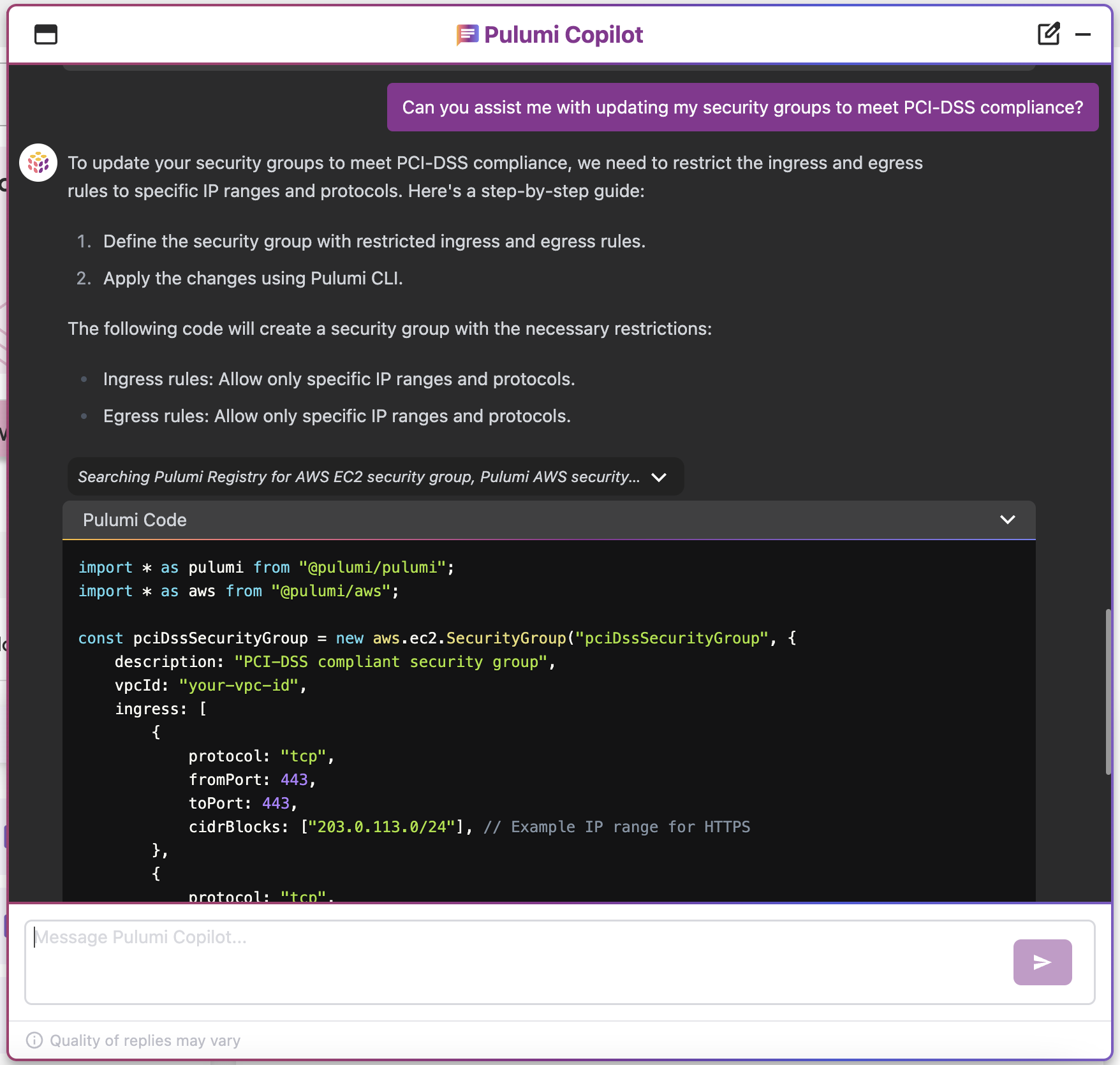How to Achieve ISO 27001 Compliance for AWS IAM
How to Achieve ISO 27001 Compliance for AWS IAM
ISO 27001 compliance is essential for ensuring the security and management of sensitive information across your organization. Pulumi can assist you in making your AWS infrastructure ISO 27001 compliant. Pulumi can help you identify existing cloud resources that are not in compliance, and it can also enforce compliance policies proactively before infrastructure is deployed. Get started with Pulumi to use these compliance tools or speak with a Solutions Architect to get an expert consultation.
What is ISO 27001 Compliance?
ISO 27001 is an internationally recognized standard for establishing, implementing, maintaining, and continually improving an information security management system (ISMS). It helps organizations protect sensitive data by providing a risk-based approach, ensuring that security measures are proportionate to the risks faced. ISO 27001 is based around the following 3 pillars: confidentiality, integrity, and availability. By achieving ISO 27001 certification, organizations demonstrate their commitment to robust information security practices and regulatory compliance.
Key Aspects of ISO 27001 Compliance
- Risk Management: ISO 27001 requires organizations to assess risks related to their information assets and implement controls to mitigate these risks.
- Security Controls: The standard includes a comprehensive set of security controls (outlined in Annex A) that cover areas like access control, cryptography, physical security, and incident management.
- ISMS Implementation: Organizations must establish an ISMS, which is a systematic approach to managing sensitive company information so that it remains secure. This involves setting policies, procedures, and controls.
- Continuous Improvement: ISO 27001 emphasizes the importance of continually monitoring, reviewing, and improving the ISMS to adapt to changing security risks and business needs.
- Compliance and Certification: Organizations can seek certification to ISO 27001 by undergoing an external audit conducted by a certification body. Certification demonstrates that an organization has implemented best practices for information security management.
- Legal and Regulatory Requirements: ISO 27001 helps organizations comply with legal, regulatory, and contractual obligations related to information security.
Pulumi Insights
Use Pulumi Insights to gain visibility into your cloud infrastructure's configuration to assess ISO 27001 compliance. Pulumi Insights is Intelligent Cloud Management. It helps you gain security, compliance, and cost insights into the entirety of your organization's cloud assets and automatically remediate issues.

Pulumi Copilot
Use Pulumi Copilot to assist configuring your infrastructure to make it compliance ready. You can tap into the Pulumi Copilot's deep understanding of your organization's context to gain visibility into the configuration of resources and assess their compliance.

Compliance Ready Policies
With comprehensive coverage of AWS, Pulumi Compliance Ready Policies provide an enhanced level of control and governance over your cloud resources. Pulumi Compliance Ready Policies empower you to enforce best practices, security standards, cost controls, and compliance requirements seamlessly within your infrastructure-as-code workflows.
What is IAM Roles and Policies?
AWS IAM (Identity and Access Management) is a service that enables you to securely manage access to AWS resources. It allows you to create and control user permissions, defining who can access specific resources and under what conditions. IAM helps ensure security and compliance by enforcing fine-grained access controls across your AWS environment.
What controls can I put in place to evaluate IAM Roles and Policies resources?
- IAM policies should not allow full "*" administrative privileges
- IAM users should not have IAM policies attached
- IAM users' access keys should be rotated every 90 days or less
- IAM root user access key should not exist
- MFA should be enabled for all IAM users that have a console password
- Hardware MFA should be enabled for the root user
- Password policies for IAM users should have strong configurations
- Unused IAM user credentials should be removed
- MFA should be enabled for the root user
- Password policies for IAM users should have strong AWS Configurations
- Ensure IAM password policy requires at least one uppercase letter
- Ensure IAM password policy requires at least one lowercase letter
- Ensure IAM password policy requires at least one symbol
- Ensure IAM password policy requires at least one number
- Ensure IAM password policy requires minimum password length of 14 or greater
- Ensure IAM password policy prevents password reuse
- Ensure IAM password policy expires passwords within 90 days or less
- Ensure a support role has been created to manage incidents with AWS Support
- MFA should be enabled for all IAM users
- IAM customer managed policies that you create should not allow wildcard actions for services
- IAM user credentials unused for 45 days should be removed
- IAM Access Analyzer analyzers should be tagged
- IAM roles should be tagged
- IAM users should be tagged
- Expired SSL/TLS certificates managed in IAM should be removed
- IAM identities should not have the AWSCloudShellFullAccess policy attached
- IAM Access Analyzer external access analyzer should be enabled
Speak to a Solutions Architect to implement policy as code to manage IAM resources for ISO 27001 compliance.
Talk to a Solutions Architect
Get in touch with our Solutions Architects to get all your resources in use with Pulumi Insights